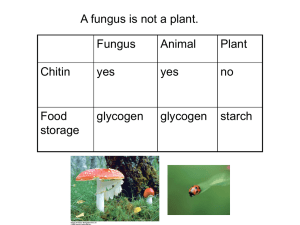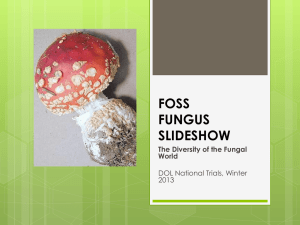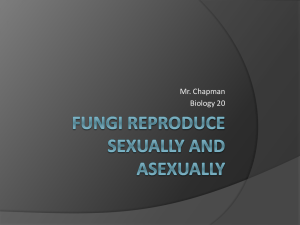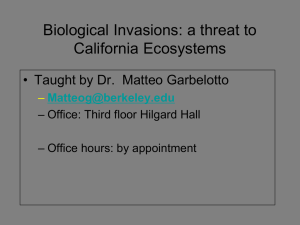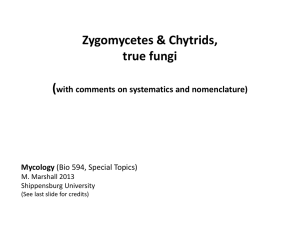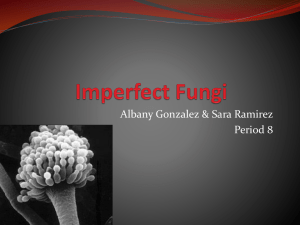chapter22_Sections 1
advertisement
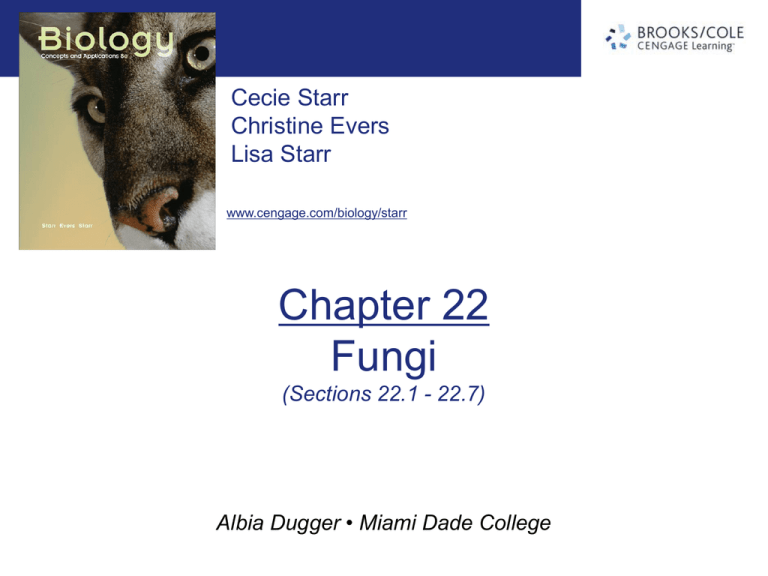
Cecie Starr Christine Evers Lisa Starr www.cengage.com/biology/starr Chapter 22 Fungi (Sections 22.1 - 22.7) Albia Dugger • Miami Dade College 22.1 High-Flying Fungi • Fungi produce microscopic spores that winds can disperse long distances • As a result, it is difficult to prevent the spread of a fungal pathogen, such as wheat stem rust • A new strain of wheat stem rust, Ug99, is able to infect most wheat varieties that were previously considered resistant Wheat Stem Rust • An infection begins when a spore lands on a wheat plant and fungal filaments invade the plant through its stomata 22.2 Fungal Traits and Diversity • Like animals, fungi are heterotrophs • Unlike animals, fungi have walled cells and digest food outside their body • fungus • Eukaryotic heterotroph with cell walls of chitin • Obtains nutrients by digesting them outside the body and absorbing them Structure and Function • Most fungi are saprobes that feed on organic remains • They serve as essential decomposers in most ecosystems • Other fungi live in or on organisms • They may be harmless, beneficial, or parasitic • saprobe • Organism that feeds on wastes and remains Structure and Function (cont.) • Fungi include single-celled yeasts and multicelled species • They disperse by releasing spores • In multicelled species, spores germinate and give rise to filaments (hyphae) which typically grow as an extensive mesh called a mycelium Key Terms • hypha • Component of a fungal mycelium • A filament made up of cells arranged end to end • There may or may not be cross-walls (septa) between cells of a hypha • mycelium • Mass of threadlike filaments (hyphae) that make up the body of a multicelled fungus Examples of Multicelled Fungi • Green mold on grapefruit • Scarlet hood mushroom Mycelium • Close-up of a mycelium, showing threadlike hyphae, each consisting of cells arranged end to end Mycelium one cell of a hypha in the mycelium Fig. 22.2, p. 344 Life Cycles • In fungi, only the zygote is diploid • Spores may form by mitosis (asexual spores) or by meiosis (sexual spores) • Depending on the group, cells of a hyphae may be haploid (n) or dikaryotic (n+n) • dikaryotic • Having two genetically distinct nuclei Fungal Diversity • In early lineages (chytrids, glomeromycetes, zygote fungi), hyphae have few or no cross-walls (septa) • More recently evolved lineages (sac fungi, club fungi) have hyphae with porous crosswalls at regular intervals • In all groups, water and nutrients move freely between cells of a hypha Key Concepts • Traits and Classification • Fungi are single-celled and multicelled heterotrophs that feed by secreting digestive enzymes onto organic matter, then absorbing the released nutrients • Multicelled species form a mesh of absorptive filaments • In the most diverse groups, cross-walls reinforce the filaments ANIMATION: Mycelium To play movie you must be in Slide Show Mode PC Users: Please wait for content to load, then click to play Mac Users: CLICK HERE 22.3 Chytrids, Zygote Fungi, and Relatives • Chytrids, zygote fungi, and glomeromycetes are the oldest and least diverse groups of fungi • chytrid • Fungus that makes flagellated spores • zygote fungus • Fungus that forms a zygospore during sexual reproduction • glomeromycete • Fungus with hyphae that grow inside the wall of a plant root cell Chytrids • The oldest fungal lineage, the chytrids are a mostly aquatic group and the only fungi with flagellated spores • Chytrids include aquatic decomposers, some that digest cellulose in herbivore guts, and parasites • Parasitic chytrid infections are pushing some frog species to extinction Zygote Fungi (Zygomycetes) • Zygote fungi include familiar molds that grow on fruits, breads, and other foods • Their hyphae are continuous tubes that have no cross-walls • Sexual reproduction produces a thick-walled zygospore • Zygote fungi also produce asexual spores on specialized hyphae Life Cycle of a Zygote Fungus 1. Black bread mold (Rhizopus) reproduces asexually as it grows through a slice of bread 2. Sexual reproduction begins when hyphae of two different mating strains meet 3. Cytoplasmic fusion of hyphal cells yields an immature zygospore that is dikaryotic 4. Fusion of the zygospore’s haploid nuclei produces the mature diploid zygospore 5. The zygospore undergoes meiosis, germinates, and produces an aerial hypha with haploid spores at its tip; each spore can give rise to a new mycelium Life Cycle of a Zygote Fungus Life Cycle of a Zygote Fungus 4 Diploid (2n) Fusion of nuclei Dikaryotic (n+n) 3 mature zygospore Meiosis Haploid (n) 5 spores young zygospore Cytoplasmic fusion mycelium 1 2 asexual reproduction Fig. 22.3, p. 345 Life Cycle of a Zygote Fungus 4 Diploid (2n) Fusion of nuclei Dikaryotic (n+n) 3 mature zygospore Meiosis Haploid (n) 5 spores young zygospore Cytoplasmic fusion mycelium 1 2 asexual reproduction Stepped Art Fig. 22.3, p. 345 ANIMATION: Zygomycete life cycle To play movie you must be in Slide Show Mode PC Users: Please wait for content to load, then click to play Mac Users: CLICK HERE Glomeromycetes • Glomeromycetes live in soil and extend their hyphae into plant roots • The hyphae branch inside plant cell walls and deliver nutrients to the cell and take up plant sugars Key Concepts • The Oldest Lineages • The oldest fungal lineages have filaments with few or no cross-walls • The mostly aquatic chytrid fungi make flagellated spores • Zygote fungi make thick-walled zygotes that release sexual spores • Glomeromycetes are fungi that branch inside plant cell walls 22.4 Sac Fungi • Sac fungi are the most diverse fungal group • They include single-celled yeasts and multicelled species such as cup fungi and morels • sac fungi • Most diverse fungal group; sexual reproduction produces ascospores inside a saclike structure (an ascus) Life Cycle • Sac fungi produce sexual spores in asci • In multicelled species, these saclike structures form on an ascocarp, a fruiting body composed of haploid and dikaryotic hyphae that have internal cross-walls at regular intervals Sac Fungus Fruiting Bodies • The cup of the scarlet cup fungus is an ascocarp • Asci, each containing eight ascospores (sexual spores) form on the cup’s inner surface A Sampling of Diversity • Yeasts that are sac fungi help us make wine, breads, and alcoholic beverages • The antibiotic penicillin was originally isolated from a mold (Penicillium) that is a sac fungus • Related molds are used to flavor cheeses Edible Ascocarps • Morels and truffles are edible ascocarps • Morels develop aboveground • Truffles form underground A Predatory Sac Fungus • Arthrobotrys captures and feeds on roundworms; rings on the hyphae constrict and entrap the worms, then hyphae grow into the captive and digest it A Predatory Sac Fungus part of one hypha that forms a nooselike ring roundworm Fig. 22.6, p. 346 VIDEO: Predatory Fungus Key Concepts • Sac Fungi • Sac fungi, the most diverse fungal lineage, include single cells such as yeasts used in baking, and multicelled species that have filaments reinforced with cross-walls • When sac fungi reproduce sexually, they produce spores inside a saclike structure 22.5 Club Fungi • Like sac fungi, multicelled club fungi have hyphae with crosswalls; they can produce complex fruiting bodies (basidiocarps) such as mushrooms • Club fungi are the only fungi that can break down lignin in wood, and are important as decomposers in forest habitats • club fungi • Fungi that produce spores in club-shaped cells Club Fungus Fruiting Bodies Club Fungus Fruiting Bodies Puffball Fig. 22.7a, p. 347 Club Fungus Fruiting Bodies Shelf fungus Fig. 22.7b, p. 347 Club Fungus Fruiting Bodies Coral fungus Fig. 22.7c, p. 347 Club Fungus Fruiting Bodies Chanterelles Fig. 22.7d, p. 347 Club Fungus Life Cycle 1. Haploid hyphal cells meet; cytoplasm fuses and forms a dikaryotic (n+n) cell 2. Mitotic cell divisions form a mycelium; produces a mushroom 3. Spore-making cells form at edges of the mushroom’s gills 4. Inside these dikaryotic cells, nuclei fuse, producing diploid (2n) cells 5. Diploid cells undergo meiosis, forming haploid (n) spores 6. Spores are released; give rise to a new haploid mycelium Club Fungus Life Cycle Club Fungus Life Cycle 4 Fusion of nuclei zygote Diploid (2n) Dikaryotic Haploid (n) (n+n) Meiosis 5 spore (n) 3 gill cap 6 stalk 1 2 Cytoplasmic fusion Fig. 22.8, p. 347 Club Fungus Life Cycle 4 zygote Diploid (2n) Fusion of nuclei Meiosis Dikaryotic (n+n) Haploid (n) 55 spore (n) 3 gill cap 6 stalk 1 2 Cytoplasmic fusion Stepped Art Fig. 22.8, p. 347 ANIMATION: Club fungus life cycle To play movie you must be in Slide Show Mode PC Users: Please wait for content to load, then click to play Mac Users: CLICK HERE Key Concepts • Club Fungi • Most club fungi are multicelled • Like the closely related sac fungi, they have filaments reinforced with cross walls • Sexual reproduction involves formation of spores in clubshaped cells • A mushroom is an example of a club fungus fruiting body 22.6 Fungi as Partners • Many fungal species are symbiotic with photosynthetic cells in lichens, while others are symbionts that live in or on plants • lichen • Composite organisms, consisting of a fungus and a single celled alga or a cyanobacterium • mycorrhiza • Mutually beneficial partnership between a fungus and a plant root Lichens • A lichen is a composite organism composed of a fungus and photosynthetic cells of a green alga or cyanobacterium • A lichen may be a mutualism or the fungus may be parasitically exploiting captive photosynthetic cells • mutualism • Mutually beneficial relationship between two species Lichens (cont.) • The fungus makes up the bulk of the lichen body and obtains a supply of nutrients from its photosynthetic partner • Lichens disperse by releasing fragments that include cells of both partners – the fungus also produces spores • Lichens are important as pioneers in new habitats; they facilitate the breakdown of rock to form soil Lichens Lichens dispersal fragment (cells of fungus and of photosynthetic species) outer layer of fungal cells photosynthetic species inner layer of loosely woven hyphae A B outer layer of fungal cells C Fig. 22.9, p. 348 Lichens Fig. 22.9a, p. 348 Lichens Fig. 22.9b, p. 348 Lichens dispersal fragment (cells of fungus and of photosynthetic species) outer layer of fungal cells photosynthetic species inner layer of loosely woven hyphae outer layer of fungal cells B Fig. 22.9b, p. 348 Lichens Fig. 22.9c, p. 348 ANIMATION: Lichens Mycorrhizae: Fungus + Roots • Most plants have mycorrhizae (mutualism between a plant root and a fungus) and grow better with them • Fungal hyphae surround or penetrate the roots and supplement the root’s absorptive surface area • The fungus shares absorbed mineral ions with the plant and gets some photosynthetic sugars in return Mycorrhiza Mycorrhiza young root hyphal strands A Fig. 22.10a, p. 348 Effects of Mycorrhizae • Seedlings grown without and with a partner fungus Key Concepts • Interactions With Other Organisms • Some fungi partner with photosynthetic cells as lichens • Others live in or on plant roots and benefit the plant by sharing nutrients • A minority of fungi are parasites • Some of these cause diseases in plants or in humans 22.7 Fungi as Pathogens • Some fungi are pathogens that attack living plants or animals • Fungi that feed on plants can be ecologically and economically important • In humans, fungal infections usually involve the skin, or are inhaled Plant Pathogens • Fungal pathogens cause wheat stem rust, powdery mildew of roses, and killed American chestnuts • One sac fungus that infects cereal grains makes a toxin that causes ergotism, a type of food poisoning that causes hallucinations, hysteria, and convulsions Ergotism • Grains of rye with spore-bearing structures of Claviceps purpurea • Eating grain infected by this species causes ergotism Human Pathogens • Inhaled fungal spores can cause histoplasmosis or coccidioidomycosis, which can be fatal to people with a weakened immune system • Fungal skin infections include “athletes foot” and “ringworm” • Yeast infections of the vagina are also common “Athlete's Foot” • Fungal skin infections include “athletes foot” High-Flying Fungi (revisited) • In 2006, sac fungus spores (Fusarium) in contact lens solution caused eye infections that resulted in cornea surgery for many patients • Fusarium species have been found in air samples collected using remote-controlled model aircraft


